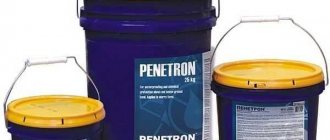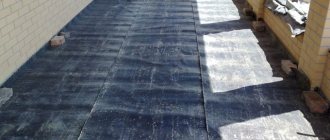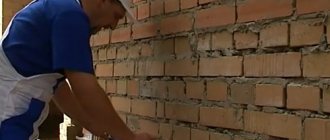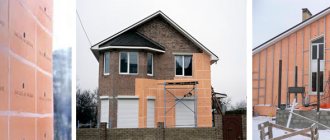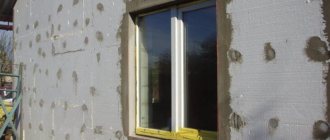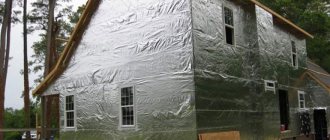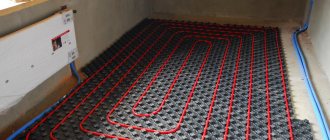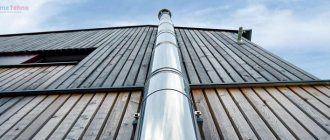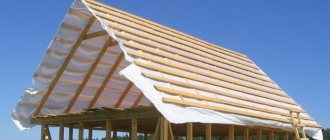Penetrating waterproofing Penetron is a dry construction mixture consisting of quartz sand of a certain fraction, special cement, and active chemical additives patented by the manufacturer. This material is used primarily for the purpose of waterproofing the surfaces of monolithic and prefabricated structures made of reinforced concrete and concrete.
Penetron helps to increase the strength, water resistance and frost resistance of concrete, provides protection for structures from the effects of all kinds of aggressive environments - groundwater and wastewater, alkalis, acids, etc. We will use the material for waterproofing surfaces that have pores and cracks, the opening width of which does not exceed 0.4 mm.
Features of the additive Penetron Admix
Penetron helps increase the water resistance of concrete, in addition, it removes microcracks and defects.
Application is allowed on all sides of structures, regardless of the direction of fluid pressure. Waterproofing systems are divided into two categories: primary - it is determined using the characteristics of the supporting structure. Secondary waterproofing, which is applied to this structure during waterproofing work and during repairs.
In primary waterproofing, water resistance is determined by the following characteristics:
- concrete;
- construction material.
The denser the concrete, the less porous it is, and its water resistance is higher. Water resistance can be increased in different ways, in particular, by introducing additives into concrete at the stage of its production; in this case, the number and diameter of capillaries and the thickness of the cavities in it are reduced in concrete.
Penetron Admix is a dry additive that is added to the concrete mixture. With its help, the water resistance of concrete structures is increased by filling the pores with crystalline formations, and the concrete is able to independently “heal” small cracks.
In an aqueous environment, the active components of Penetron Admix enter into a chemical reaction with ionic complexes based on aluminum and calcium, as well as with salts and oxides that are found in concrete.
Technical characteristics of Penetron Admix
With the help of this composition, the waterproof grade of concrete increases after treatment. In addition, the frost resistance of the material increases. Penetron can also be used for drinking liquid reservoirs.
Penetron Admix is the primary form of material protection; it helps eliminate waterproofing of the material after reaching the required strength.
Its use according to the instructions is allowed together with other additives that are often used in concreting, for example, anti-frost and plasticizing.
Technical specifications
To increase the effectiveness of using the Penetron Admix additive, you should study its technical characteristics presented in the following table.
| Appearance | gray powder, free of impurities, uniform consistency |
| Humidity | no more than 2.5% |
| Possibility of increasing the water resistance grade | no less than 4 points |
| Increasing the compressive strength of concrete | 10% |
| Increasing the frost resistance of concrete | for at least 100 freezing cycles |
| Resistance of the material to various acids | present |
| Resistance of concrete to alkalis | There is |
| Resistance of the treated material to the action of light and dark petroleum products | Present |
| UV resistance | Eat |
| Possibility of use for forming reservoirs for storing drinking water | Allowed |
| Acidity of the environment where the use of treated concrete is allowed | 3-11 pH |
| Operating temperature range | -60…+130°С |
| Storage requirements for Penetron Admixa | at temperatures -60…+50°С, at any humidity level |
| Shelf life of the material | 1.5 years |
Detailed instructions for use of the composition
Below we will describe the stages of work on waterproofing concrete surfaces using Penetron.
Preparing the surface for applying Penetron
The first stage of work is cleaning the concrete surface. It needs to be removed from particles such as:
- dust;
- petroleum products;
- dirt;
- cement milk;
- layer of plaster;
- tile;
- dye;
- and other elements that can become an obstacle to the penetration of Penetron into the concrete structure.
The surface is cleaned using a special high-pressure water jet, or another mechanical method convenient for you. For example, using a brush with metal bristles.
Smooth and polished surfaces should be treated with a weak acid solution and rinsed with water after about an hour. Residual water remaining on a horizontal surface after using a water jet unit should be removed with a special vacuum cleaner.
Next, you need to make U-shaped grooves with a cross-section of about 25 by 25 mm along the length of the presence of joints, seams or interfaces, as well as around the place where communications are introduced. They should be cleaned with a brush with metal bristles and the loose concrete layer, if present, should be removed.
Use a jackhammer to cut cavities of pressure leaks to a width of 25 mm and a depth of 50 mm, taking into account internal expansion. The internal cavity should also be cleaned of loose and peeling concrete.
How to prepare the composition of Penetron
Let's start preparing the mixture. To do this, take dry Penetron and mix it with water in the following proportions:
- 400 ml of liquid per kilogram of penetron;
- one part liquid to two parts penetron.
You must first pour the mixture into the container and only then dilute it with water; you cannot do the opposite. Remember the following:
- stir the mixture for one to two minutes by hand or with a low-speed drill;
- it should look like a liquid, creamy solution;
- you need to prepare the solution in the amount that you will have time to apply within half an hour;
- When using the Penetron solution, do not forget to constantly stir so that it maintains its original consistency.
Waterproofing concrete structures
After you have cleaned and moistened the concrete surface and prepared a Penetron-based composition, it must be applied in two layers using a brush with synthetic fiber or a mortar pump equipped with a spray nozzle. The first layer of Penetron solution should be applied to the wet concrete surface. And the second one needs to be applied to a fresh first layer, which has already had time to set. But do not forget that the surface should be moistened before applying the second layer.
Penetron consumption, taking into account application in two layers, is about a kilogram per square meter and can increase if there are unevenness or potholes on the surface.
Also remember that cracks, joints, junctions and service entries should be sealed using Penecrete, but for pressure leaks you should use Waterplug or Peneplug.
New insulation between concrete and porous wall
To ensure reliable horizontal waterproofing between a concrete foundation and a porous wall, it is necessary to treat the horizontal part of the concrete surface with Penetron to create a barrier that prevents capillary suction of liquid. By porous materials we mean the following:
- brick;
- wooden;
- cellular concrete and others.
Waterproofing for walls made of stone or brick
If you want to ensure waterproofing of the structural elements of a building based on bricks or stones, then their surface must be covered with plaster and treated with Penetron solution under the following conditions:
- The surface must be plastered using a mortar of the M150 brand based on cement and sand. It is strictly forbidden to use lime or gypsum;
- Plastering should only be done on a masonry grid with cell sizes of 50 by 50 mm or 100 by 100 mm. The mesh must be firmly attached to the surface, and the gap between it and the brick base must be at least 15 mm;
- the plaster layer should have a thickness of 40 mm and above;
- the structure of the plaster layer should be dense and have no air gaps. It is advisable to carry out plastering continuously so that there are not a large number of working seams;
- The surface after plastering must be kept for at least a day before applying Penetron to it.
How to waterproof brick and stone walls
To equip parts of a structure made of stone or brick with waterproofing, the surface must first be plastered and then treated with Penetron solution. All this is done subject to the following conditions:
- The surface must be plastered using a cement-sand composition, the grade of which is at least M150. Gypsum plaster and lime mortars should not be used.
- Plastering is carried out exclusively on a masonry mesh that is well attached to the surface. The gap between such a mesh and the base of bricks should be at least 15 mm.
- The thickness of the plaster layer must be at least 40 mm.
- The structure of this layer must be dense and not contain air gaps. It is necessary to plaster continuously to prevent the appearance of working seams in large quantities.
- After plastering, the surface must be left for at least a day before applying Penetron to it.
The consumption of the composition for application in terms of dry material, taking into account the use of two layers, is approximately 800 grams per square meter.
Application of building composition
If you follow the step-by-step instructions for applying the substance, the process will not cause difficulties, and the result will certainly please you. This work consists of the following stages:
- preparing the concrete surface;
- preparing the solution;
- design processing;
- care;
- facing works.
So, enough theory, let's get to practice. Don't forget to follow all safety rules.
Preparing the concrete surface
To obtain a first-class result, we take the preparatory stage extremely seriously, otherwise the work will go down the drain. So we do the following:
- thoroughly clean the surface of dirt, paint, dust, tiles, cement laitance, plaster, petroleum products, as they will interfere with the penetration of the substance;
- treat the cleaned concrete surface well with an acid solution (weak), and after an hour, wash it off;
- remove the water using a special device (install a compressor and blow with strong air pressure);
- we make grooves in the shape of the letter “P” along the length of seams, joints, etc.;
- clean the grooves using a metal bristle brush;
- remove the loose layer;
- we separate the leak cavities using a hammer drill or jackhammer (width - 25 mm, depth - 50 mm with expansion in depth);
- we clean the cavity from porous stone material;
- saturate the sanded surface with water - this is the main requirement when working with an innovative substance.
Preparation of the substance
To make a high-quality solution, we follow the proportions and, of course, listen to the recommendations of the gurus of architectural art:
- pour the substance – 1 kg into a plastic bucket and fill it with water – 0.4 l;
- mix the components using a puncher and a special attachment for 3 minutes.

Attention! Remember:
- the appearance of the solution is a creamy substance;
- prepare the solution for half an hour of work (no more);
- We regularly stir the substance so that it does not thicken, otherwise you will have to prepare fresh, since adding water is strictly prohibited.
Surface waterproofing
To ensure the job is done flawlessly:
- cover the surface with the solution using a synthetic fiber brush or a regular roller;
- we take a technical break so that the solution “sets”;
- moisturize the concrete surface;
- Apply the second layer of the composition evenly.
The average consumption of Penetron is 0.9–1.3 kg/m2, however, if there are irregularities, of course, more mixture will be required.
Caring for treated concrete surfaces
For excellent results, for 75 hours the surface:
- we protect from any influence of climatic and mechanical factors;
- We regularly moisturize, otherwise cracks and peeling will appear.
Cladding work
We decorate the structure with tiles, mosaics or other materials after 30 days. Before facing work, be sure to thoroughly clean the surface with a wire brush to improve adhesion. You can “lightly run” over the surface with a regular sanding machine.
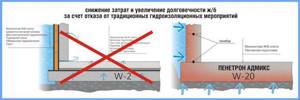
Don’t forget, simple steps will extend the service life of any concrete structure. "Penetron" is a profitable investment in the future of your construction site!
I will end here. I hope that it was informative not only for builders, but also for owners of concrete cellars and swimming pools. If yes, then recommend the article to your friends, maybe someone will find this information useful. And I’m not saying goodbye to you. See you soon on other blog pages. Good luck to everyone and bye bye!!!
Wisdom Quote: It only takes one minute to be surprised; It takes many years to do an amazing thing (Helvetius Claude Adrian).
Penetron - penetrating waterproofing
The penetrating composition Penetron is the main material produced by the Penetron plant.
Buckets - 5, 10 and 25 kg. Karft bag - 25 kg.
Declaration of conformity for Penetron material download
Penetration into concrete up to 90 centimeters!
Material Penetron
A composition intended to impart waterproof properties to ready-made concrete structures. It is produced in the form of a dry mixture consisting of chemically active components, purified sand and cement. Penetrates into the concrete base to a depth of 55 centimeters! When penetrating into the body of the concrete field, it creates crystalline bonds that are insurmountable for the penetration of water in capillaries and pores.
Application of Penetron dry mixture
Use only on well-moistened concrete. The better the concrete is saturated with water, the better the active substances will penetrate inside.
Preparation
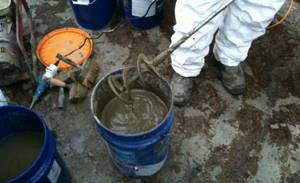
The dry mixture is diluted with water in the proportion of 2 kilograms of mixture per 1 liter of water in a clean container. Mixing is done using a drill with a special attachment at low speed.
Apply the mixture only to damp concrete!
Application
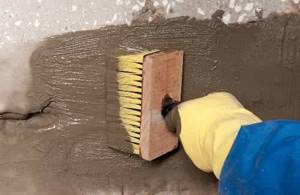
The prepared Penetron solution is applied to a cleaned and well-moistened concrete surface. The more the concrete is saturated with water, the better! The concrete surface is cleaned of contaminants using a metal brush or a weak acid solution. In addition to cleaning from contaminants, the pores are opened.
Application is carried out in two layers. The first layer is vertical, the second - after an hour horizontally. This prevents the appearance of untreated areas. After application, moisten the concrete for 2-4 days. At high ambient temperatures (summer), it is advisable to cover the concrete with a film or membrane.
Why should concrete be protected?
The concrete field is a structural monolith with many cracks, pores and capillaries. Water, freely penetrating this complex structure, saturates the concrete. Excess moisture in concrete leads to water penetrating not only into the building envelope, but also into the interior of the premises. Also, when exposed to low temperatures, water during the freezing process destroys the concrete field.
Water penetration
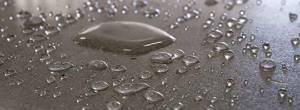
To prevent moisture from entering the concrete, the penetrating composition Penetron is used. Inside the pores and capillaries of concrete, the composition creates insoluble bonds that completely prevent the free passage of water.
Dry building mixture "Penetron" is a penetrating waterproofing material that protects concrete from the effects of water by increasing its water resistance. The composition of Penetron is a cement-sand mixture with the addition of chemically active reagents. These components provide active resistance when aggressive media penetrate into the concrete structure through cracks up to 0.4 mm and other damage. Properly performed waterproofing using Penetron will solve all problems associated with exposure to moisture for many years.
Where and how to use the Penetron composition
Penetrating waterproofing is used to strengthen concrete structures that are in active contact with water and exposed to bacteria, salts, acids, alkalis or marine organisms.
The unique properties of Penetron are used for external protection of buildings from moisture, drying them from the inside, and combating leaks. The greatest effect is achieved when using this product in combination with other waterproofing materials of the Penetron system. To protect seams, abutments, joints and service inputs, as well as in case of pores and cracks with an opening width of 0.4 mm, “Penecrite” is used in combination with “Penetron”, and “Peneplug” or “Waterplug” is used to eliminate pressure leaks "
The scope of application of the material is quite extensive and includes waterproofing of a wide variety of objects: residential buildings, industrial and public buildings, subways, tunnels, sports facilities (stadiums, swimming pools, sports complexes), underground parking lots, vegetable stores, mines, bridges, piers, dams, drinking tanks, pumping stations, wells, as well as parts of buildings - basements, walls, floors, balconies.
Main application steps
Penteron can be used to treat any side of the structure. To apply the mixture you need to perform a number of steps.
- Remove plaster, paint and other foreign materials or contaminants from the concrete surface. The surface must be clean so that the active particles of the mixture can freely penetrate through it into the concrete.
- Treat the concrete surface with a 10% acetic acid solution.
- After an hour, rinse the surface with water. It is necessary that the concrete is well saturated with water before applying a waterproofing mixture to it.
- Prepare a mixture (1 kg of Penetron + 400 g of water). The mixture can be made in any volume, based on the mass ratio: 2 parts Penetron: 1 part water. The result should be a solution that is not too thick (like sour cream). It is prohibited to add water to the prepared solution.
- Apply the prepared mixture using a brush or pump with a special nozzle.
For maximum protection, two layers of Penetron are created. The second layer is applied to the already set first layer with preliminary moistening. After this, the treated surface must be protected from rain and temperatures below +5°C for 3 days, making sure that it is damp. Moisturizing should continue for two weeks. Moisture plays a big role in this process, since the active components of the mixture dissolve and react in the water that impregnates the concrete.
Composition, scope of application and advantages of products
"Penetron" is a penetrating waterproofing that protects concrete from the harmful effects of climatic factors, in addition, improving its technical characteristics.
Product components
The substance, which has extremely positive reviews, contains the following ingredients:
- Portland cement;
- quartz sand;
- chemical additives.
It would seem nothing special, but when all the components are combined, a substance is born that fills microcracks in concrete and creates crystals that prevent liquid penetration.
Areas of product use
The innovative mixture "Penetron" is used for reliable protection:
- public and private buildings - waterproofing basements, foundations, balconies and other real estate;
- hydraulic complexes - berths, swimming pools, etc.;
- industrial and energy complexes - mines, storage facilities, tunnels, subways, pumping stations, etc.
Product advantages
"Penetron" for concrete is known for a number of advantages:
- fire safety;
- waterproof;
- environmental friendliness;
- durability;
- ease of application;
- frost resistance;
- self-healing of any kind of damage;
- efficiency;
- non-toxic;
- versatility.
In general, the substance is not subject to the harmful effects of chemical, thermal, mechanical, climatic, and biological factors. Moreover, the mixture significantly improves the technical characteristics of concrete. Isn't this a miracle? No wonder the formula is kept secret.
https://youtube.com/watch?v=bDg_eNLe2f4
Description of penetrating waterproofing Penetron
| DESCRIPTION. The dry construction mixture consists of special cement, quartz sand of a certain granulometry, and patented active chemical additives. PURPOSE. Penetron is used for waterproofing the surfaces of prefabricated and monolithic concrete and reinforced concrete structures. Increases the water resistance, strength, and frost resistance of concrete. Protects the structure from exposure to aggressive environments: acids, alkalis, sewage and groundwater, sea water. Used for waterproofing surfaces with pores and cracks with an opening width of no more than 0.4 mm. |
Attention! For waterproofing cracks with an opening width of more than 0.4 mm, seams, joints, mates, abutments, utility entries, Penecrit is used in combination with Penetron
Advantages of penetrating waterproofing Penetron
Why is penetrating waterproofing today the most progressive and technologically advanced method of protecting concrete from the harmful effects of water?
- Penetrating waterproofing is not subject to mechanical wear, since the concrete itself has waterproofing properties. The service life of waterproofing is equal to the service life of concrete, and due to waterproofing of concrete, this period increases.
- The use of penetrating waterproofing is more technologically advanced. There is no need to completely dry the concrete. Thanks to the penetrating properties of Penetron, the concrete structure can be processed from any side, in other words, when processing the foundation there is no need to dig it out.
- Penetrating waterproofing Penetron has unique properties of self-healing through cracks, pores and other defects that inevitably appear on any concrete structures during operation, with an opening of no more than 0.5 mm. If water begins to seep into the newly formed pores of concrete, crystal growth resumes.
- Penetron gives a gradual increase in the water resistance of concrete to W20 (2 MPa) and higher, for example, when testing the water resistance of concrete samples with the waterproofing additive Penetron with the effect of self-healing of cracks, the water resistance grade increases from W4 to W10 after the next 28 days and from W14 to W20 in within 90 days.
- Penetron does not affect the basic physical parameters of the concrete mixture: mobility, strength, setting time, etc., with the exception of water resistance. Concrete treated with Penetron retains vapor permeability.
The branded material Penetron will help even in conditions where other dry building mixtures cannot cope. So, as already noted, the operation of the branded waterproofing material Penetron is based on a completely different principle. Typically, waterproofing is superficial. By applying surface waterproofing materials to the concrete plane, we create a certain protective layer that prevents the penetration of water.
Operating principle of penetrating waterproofing Penetron
When a liquid solution of penetrating waterproofing material “Penetron” is applied to wet concrete, a high chemical potential is created on the surface, while the internal structure of the concrete retains a low chemical potential. Osmosis tends to equalize the potential difference; osmotic pressure occurs. Due to the presence of osmotic pressure, the active chemical components of the Penetron material penetrate deep into the concrete structure. The higher the humidity of the concrete structure, the more efficient the process of penetration of active chemical components into the depths of concrete. This process occurs under both positive and negative water pressure. The depth of penetration of the active chemical components of the Penetron material in a continuous front reaches several tens of centimeters.
Chemical resistance of concrete after applying penetrating waterproofing
Chemical resistance and anti-corrosion properties of concrete after using Penetron penetrating waterproofing.
Testing of penetrating waterproofing material Penetron
The action of the Penetron material is based mainly on osmotic pressure, reactions in the solid state and Brownian motion. The chemical components of the dry mixture "Penetron", dissolving in water, penetrate deeply into the structure of concrete and react with the components of the hardening products of cement stone.
Primary and secondary waterproofing of building structures
Having understood the reasons for the destruction of building structures from exposure to water, and having made sure that structures that are constantly or temporarily in contact with water need to be waterproofed, you need to understand when and with what help waterproofing work is performed.
Since today there are two methods of waterproofing: primary waterproofing and secondary.
Our following video will help you with this:
Penetrating waterproofing "Penetron" is the most effective primary protection for concrete structures!
Preparation for use of Penetron waterproofing mixture
Construction waterproofing mixture requires preliminary preparation of the insulated surface.

Dry waterproofing penetrating capillary mixture - Penetron brand
Preparation is carried out according to the following principle:
- Clean the concrete surface from dirt, dust, cement laitance, petroleum products, layers of plaster, shotcrete, paint, tiles and other materials that may prevent the penetration of chemically active components of the Penetron system.
- Cleaning of the concrete surface is carried out using high-pressure water jets (water jet) or another acceptable mechanical method, for example, a brush with metal bristles.
- A smooth and polished surface is treated with a low concentrated acid solution and washed with water for an hour. Excess water formed on the surface is removed using a special vacuum cleaner. Penetrating waterproofing in this case will penetrate better into the concrete.
- Along the entire length of seams, cracks, mates, abutments, joints and around the entrance of communications, U-shaped grooves with a cross-section of at least 25 * 25 mm are made. Clean the grooves with a brush with metal bristles, and if necessary, remove the loose concrete layer.
- Using a jackhammer, the cavities of pressure leaks are divided into widths and depths of at least 25 and 50 mm, respectively, with an expansion inward (if possible, in the shape of a swallow’s tail). Clean the internal leak cavity from exfoliated, loose concrete.
- Immediately before applying the Penetron mixture, the concrete surface should be thoroughly moistened until the concrete structure is completely saturated with water.
Surface preparation
First of all, it is necessary to thoroughly clean the surface of dirt and dust. It is imperative to remove paint and tiles, petroleum-based compounds, residual elements of cement and plaster, as well as other materials.
Concrete bases are cleaned using a high pressure water jet. If it is not possible to use it, a regular brush with metal bristles, as well as other cleaning methods, will do. A weak acid solution can be used to treat both smooth and sanded coatings, but it must be taken into account that after using it, the surface must be washed with clean water within the next hour, the remnants of which must be removed with a special vacuum cleaner.

Along the entire length of the elements that require processing, it is necessary to apply U-shaped fines with a minimum cross-section of 25x25 millimeters.
This applies to joints and seams, cracks and adjacent communications. The fines must be cleaned with a special brush and the loose concrete layer must be removed.
Advantages of using Penetron waterproofing agent
This is because the product has many advantages:
- — penetrating waterproofing has no mechanical wear, because all moisture-protective functions are transferred to concrete. The service life of such a coating will be equal to the service life of the surface itself where it was applied;
- - the most technologically advanced way to use it. The penetrating properties of the mixture will perform their functions even without drying the concrete;
- — the Penetron mixture does not change the physical properties of concrete. It simply adds the property of waterproofness;
- — suitable for waterproofing the external and internal sides of structures;
- — penetrating waterproofing can withstand various temperature changes and is resistant to chemical and mechanical influences.
The price of this brand for one package in different stores will vary, starting from approximately 200 rubles.
